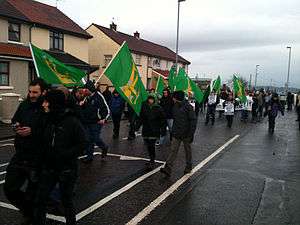Starry Plough (flag)
.jpg) | |
| Names | The Starry Plough, Plough and Stars flag |
|---|---|
| Use |
Other |
| Proportion | 1:1 |
| Adopted | 1914 |
| Design | A yellow plough with a sword for a coulter outlined in black with seven silver stars outlined in black. |
| Designed by | William H. Megahy or George William Russell[1] |


The Starry Plough banner (Irish: An Camchéachta) is a flag which was originally used by the Irish Citizen Army, a socialist Irish republican movement, and subsequently adopted by other Irish political organizations.
Composition
The original Starry Plough was designed by George William Russell for the Irish Citizen Army[2] and showed silver stars on a green background.[3] The flag depicts an asterism (an identified part) of the constellation Ursa Major, called The Plough (or "Starry Plough") in Ireland and Britain, the Big Dipper in North America, and various other names worldwide. Two of the Plough's seven stars point to Polaris, the North Star. James Connolly, co-founder of the Irish Citizen Army with Jack White and James Larkin, said the significance of the banner was that a free Ireland would control its own destiny from the plough to the stars.[4]
History
The original Starry Plough was unveiled in 1914 and flown over the Imperial Hotel by the Irish Citizen Army during the 1916 Easter Rising. The 1916 flag is on display at the National Museum, Collins Barracks, in Dublin.[5]
At public performances of The Plough and the Stars, the Seán O'Casey play which takes its name from the flag, riots were known to break out when the Starry Plough appeared.[6][7]
During the 1930s the design changed to a blue banner which was designed by members of the Republican Congress, and was adopted as the emblem of the Irish Labour movement, including the Irish Labour Party. Labour adopted the rose as its official emblem in 1991 but continue to use the Starry Plough for ceremonial occasions. It is also used by Irish republicans and has been carried alongside the Irish tricolour and Irish provincial flags and the sunburst flag, as well as the red flag at Provisional IRA, Continuity IRA, Real IRA, Official IRA, Irish People's Liberation Organisation and Irish National Liberation Army rallies and funerals.
The flag, and alternative versions of it, are also used by Saoradh éirígí, the Connolly Youth Movement, Republican Sinn Féin, Labour Youth, Ógra Shinn Féin, Communist Party of Ireland, the Republican Socialist Youth Movement, and socialist Celtic F.C. supporters. In the past it was used by the Sligo/Leitrim Independent Socialist Organisation before it merged with the Irish Labour Party. The flag was draped on the coffin of the Independent TD Tony Gregory during his funeral.[8]
The older banner featuring the plough is still occasionally used today by the Irish Republican Socialist Party, Sinn Féin, the Workers' Party of Ireland (formerly known as Official Sinn Féin) and many other socialist republican parties.
While similar to the state flag of Alaska, it predates Alaska's by more than a decade.
See also
- The Plough and the Stars, the pacifist play by Seán O'Casey (1926)
- Flag of Alaska (a similar design)
- Plough flag (a similar design)
References
- ↑ Higgins, Michael D. (April 30, 2013). "Remarks at the Conservation of the original Starry Plough Flag". www.president.ie. Office of the President of Ireland. Retrieved 20 February 2017.
- ↑ "Irish Literary Portraits" ed. W. R. Rodgers p.195
- ↑ "History of Starry Plough Flag". Angelfire.com. 1989-11-06. Retrieved 2010-07-23.
- ↑ "The Plough and the Stars Irish Theatre Players Perth". www.dfa.ie. Department of Foreign Affairs. Retrieved 20 February 2017.
- ↑ "Object: Plough and the Stars Flag". www.rte.ie. Raidió Teilifís Éireann. Retrieved 20 February 2017.
- ↑ Ayling, Ronald; Worth, Katharine (1969). "O'Casey's Dramatic Symbolism". Sean O’Casey: Modern Judgements. Springer. p. 184. ISBN 9781349153015. Retrieved 24 October 2017.
- ↑ Crawley, Peter (March 18, 2016). "Culture Shock: 'The Plough and the Stars' is back. Must be time for a riot, so". The Irish Times. Retrieved 24 October 2017.
- ↑ "Hundreds attend Tony Gregory funeral". RTE.ie. Raidió Teilifís Éireann. 7 January 2009. Retrieved 20 February 2017.